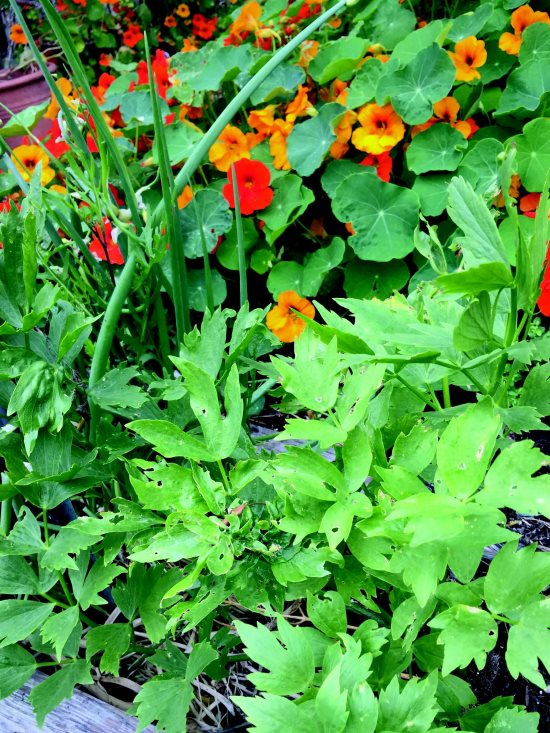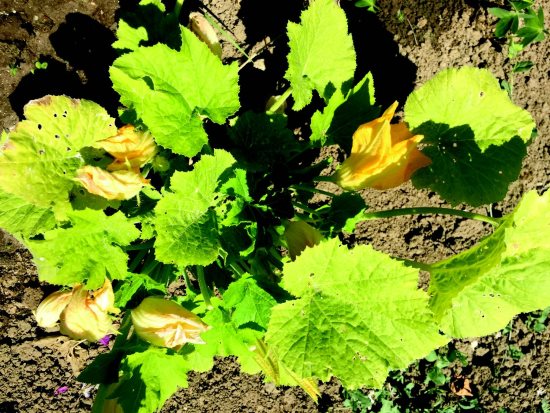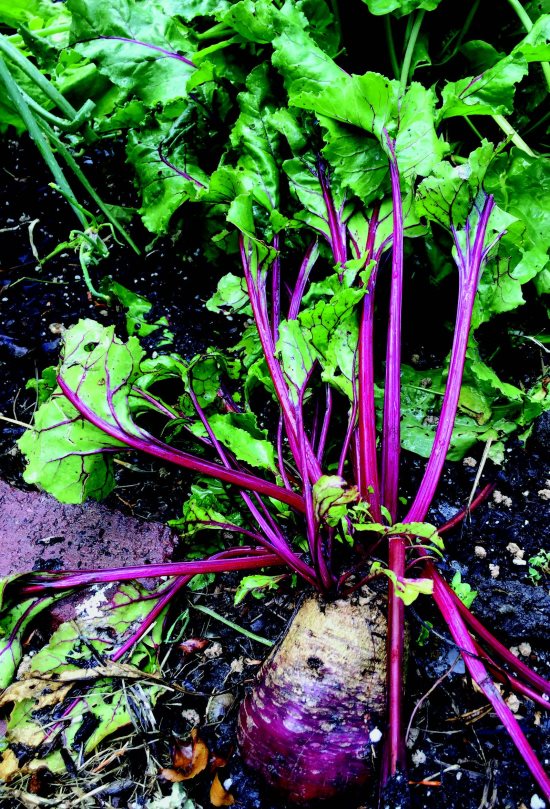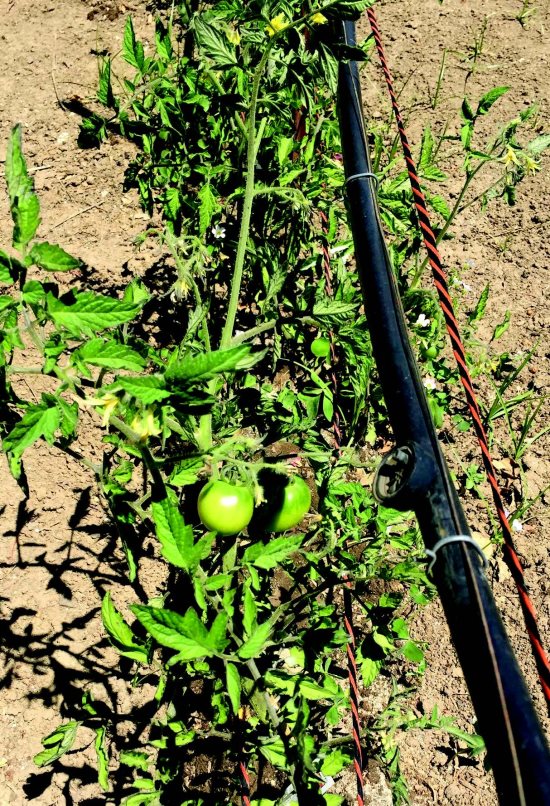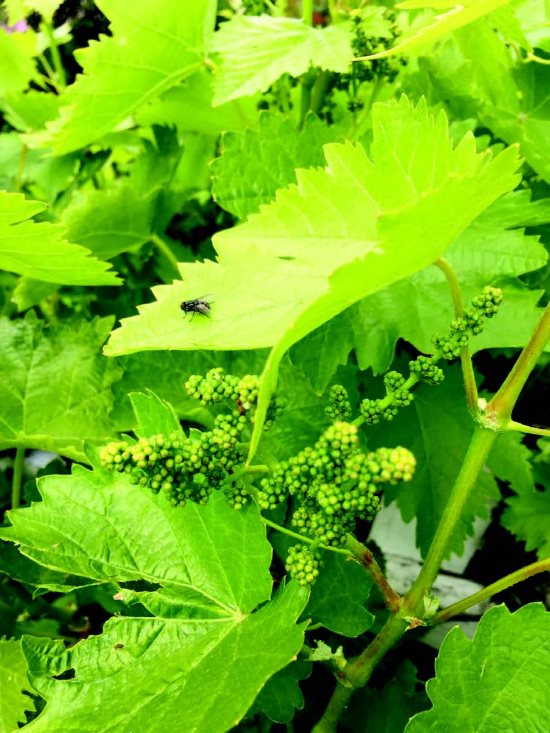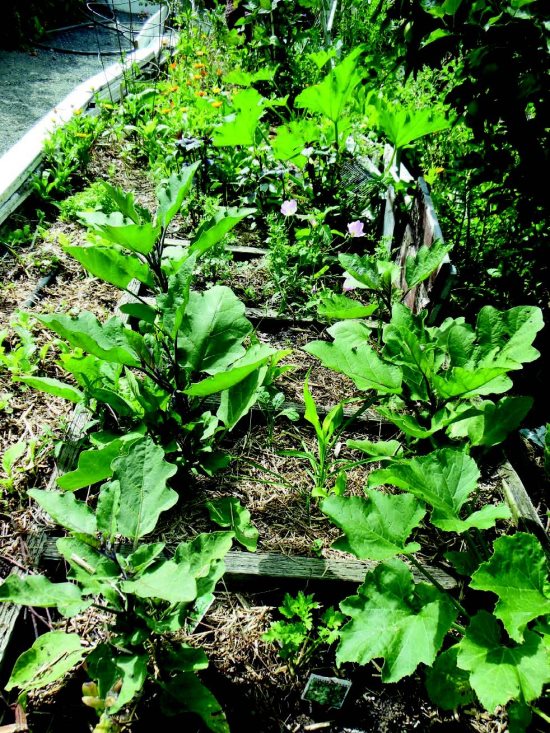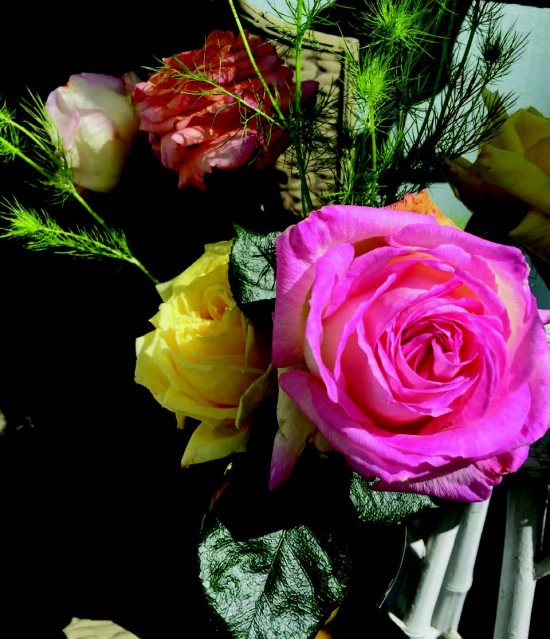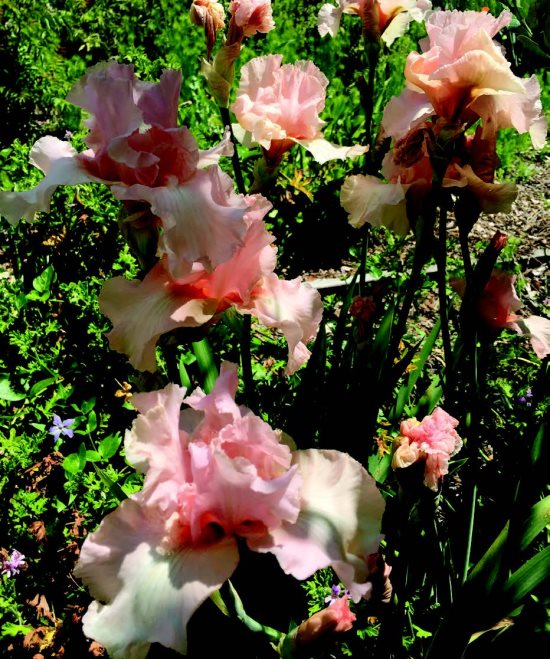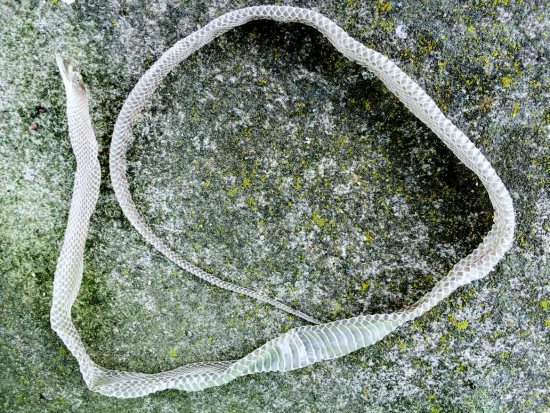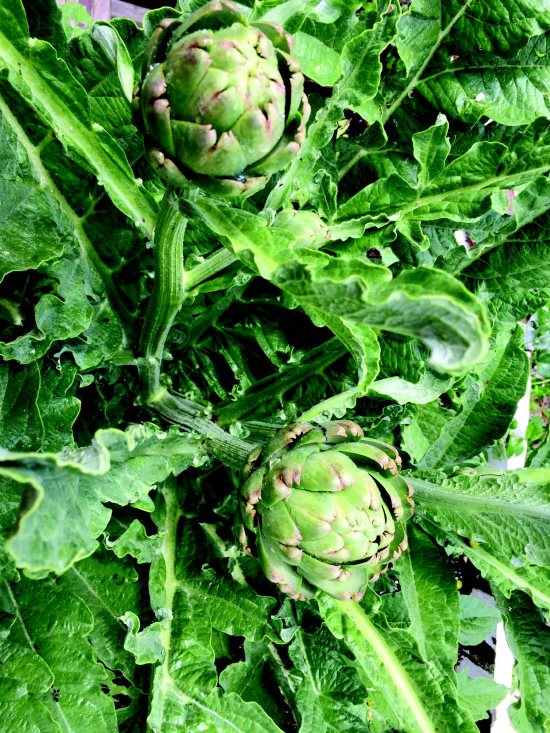 |
|
|
Artichokes are ready for harvesting. Photo Cynthia Brian
|
|
|
|
|
|
"There are only two things that money can't buy: true love and homegrown tomatoes!"-John Denver
 Is there anything more satisfying than plucking a sun-ripened juicy tomato directly from the vine and munching on it right where you stand accompanied by a sprig of basil? Growing my own food is true love.
Is there anything more satisfying than plucking a sun-ripened juicy tomato directly from the vine and munching on it right where you stand accompanied by a sprig of basil? Growing my own food is true love.
 Because of the long distances of travel, on Mother's Day, I didn't get the pleasure of spending time with my two adult children. Instead I did the next best thing: I spent nine glorious hours spading, weeding, planting, watering, and mulching my vegetable garden. I sowed seeds of beans, cucumbers, cantaloupes, lettuces, Swiss chard and marigolds. Seedlings of various types of heirloom tomatoes, peppers, zucchini and eggplant were tucked between nasturtiums and calendulas. Within 60 days, I'll begin harvesting fresh, organic produce. Artichokes, beets, sorrel and arugula are already gracing our plates. Grapevines surround the perimeter as a living fence and favorite herbs including thyme, sage, rosemary, oregano, parsley, basil, lemon verbena, chervil, spearmint, lovage, lemon grass, fennel, lavender and pineapple mint form borders.
Because of the long distances of travel, on Mother's Day, I didn't get the pleasure of spending time with my two adult children. Instead I did the next best thing: I spent nine glorious hours spading, weeding, planting, watering, and mulching my vegetable garden. I sowed seeds of beans, cucumbers, cantaloupes, lettuces, Swiss chard and marigolds. Seedlings of various types of heirloom tomatoes, peppers, zucchini and eggplant were tucked between nasturtiums and calendulas. Within 60 days, I'll begin harvesting fresh, organic produce. Artichokes, beets, sorrel and arugula are already gracing our plates. Grapevines surround the perimeter as a living fence and favorite herbs including thyme, sage, rosemary, oregano, parsley, basil, lemon verbena, chervil, spearmint, lovage, lemon grass, fennel, lavender and pineapple mint form borders.
 If you want to enjoy fresh flavor and fanciful flair straight from your yard this summer, these are the final days to sow and plant. Growing your own vegetables and herbs means that you will always have plenty of the most nutritious and succulent ingredients for your meals. You don't need a large yard to accommodate your culinary and dietary requirements. In fact, starting small is best for beginners.
If you want to enjoy fresh flavor and fanciful flair straight from your yard this summer, these are the final days to sow and plant. Growing your own vegetables and herbs means that you will always have plenty of the most nutritious and succulent ingredients for your meals. You don't need a large yard to accommodate your culinary and dietary requirements. In fact, starting small is best for beginners.
 The three essentials:
The three essentials:
 1. A location with six or more hours of sunlight
1. A location with six or more hours of sunlight
 2. Rich, amended soil
2. Rich, amended soil
 3. Water
3. Water
 The location can be in the ground or in containers. The key is to have as much sunlight as possible. A raised bed measuring 4 x 4 x 8 feet will offer a great starting point. If you only have a balcony, porch or patio, buy containers large enough to allow roots to thrive.
The location can be in the ground or in containers. The key is to have as much sunlight as possible. A raised bed measuring 4 x 4 x 8 feet will offer a great starting point. If you only have a balcony, porch or patio, buy containers large enough to allow roots to thrive.
 Rich soil is paramount for growing all vegetables. Buy bags of soil engineered for growing edibles or enrich your current soil with copious amounts of compost. Since it's at the end of the planting season for summer vegetables, buying soil will ensure a better outcome. Make sure that you have proper drainage. You don't want water stagnating or draining too quickly.
Rich soil is paramount for growing all vegetables. Buy bags of soil engineered for growing edibles or enrich your current soil with copious amounts of compost. Since it's at the end of the planting season for summer vegetables, buying soil will ensure a better outcome. Make sure that you have proper drainage. You don't want water stagnating or draining too quickly.

 Watering consistently is essential, especially in the first few weeks of either sowing the seeds or planting the seedlings. Once established, you'll need to watch how much water your plants covet.
Watering consistently is essential, especially in the first few weeks of either sowing the seeds or planting the seedlings. Once established, you'll need to watch how much water your plants covet.
 What to plant:
What to plant:
 The best advice is to only plant what your family enjoys eating. If you love carrots and turnips, make sure to include them in your design. If you only want fresh tomatoes, then that's your ticket to paradise. Many people attempt to plant too much, then, get frustrated when things either don't flourish or produce a plentitude.
The best advice is to only plant what your family enjoys eating. If you love carrots and turnips, make sure to include them in your design. If you only want fresh tomatoes, then that's your ticket to paradise. Many people attempt to plant too much, then, get frustrated when things either don't flourish or produce a plentitude.
 I like to grow a bit extra to give away to friends and to freeze in sauces for the winter months. If you do grow an overabundance of crops, local food banks are always happy to accept your overflow. Also, failure is fertilizer. When a plant dies, throw it in the compost pile to grow a richer garden.
I like to grow a bit extra to give away to friends and to freeze in sauces for the winter months. If you do grow an overabundance of crops, local food banks are always happy to accept your overflow. Also, failure is fertilizer. When a plant dies, throw it in the compost pile to grow a richer garden.
 When buying seeds, choose high quality seeds from reputable companies or sow seeds that have been saved from high yielding collections. Cheap or inadequate seeds may not germinate, wasting time, space, and money. For select varieties of tomatoes, eggplant, squash and peppers, I prefer buying individual plants so that I have the ability to try a diverse assortment of heirloom and new selections.
When buying seeds, choose high quality seeds from reputable companies or sow seeds that have been saved from high yielding collections. Cheap or inadequate seeds may not germinate, wasting time, space, and money. For select varieties of tomatoes, eggplant, squash and peppers, I prefer buying individual plants so that I have the ability to try a diverse assortment of heirloom and new selections.
 Easy to grow from seed:
Easy to grow from seed:
 Carrots
Carrots
 Radishes
Radishes
 Lettuces
Lettuces
 Beets
Beets
 Sorrel
Sorrel
 Arugula
Arugula
 Chard
Chard
 Beans
Beans
 Peas
Peas
 Spinach
Spinach
 Cucumbers
Cucumbers
 Fennel
Fennel
 Cilantro
Cilantro
 Chervil
Chervil
 Parsley
Parsley
 Corn (you need a large space for corn)
Corn (you need a large space for corn)

 Easiest to grow from transplants:
Easiest to grow from transplants:
 Eggplant
Eggplant
 Zucchini
Zucchini
 Tomatoes
Tomatoes
 Peppers
Peppers
 Squash
Squash
 Melons
Melons
 Rosemary
Rosemary
 Basil
Basil
 Thyme
Thyme
 Sage
Sage
 Oregano
Oregano
 Marjoram
Marjoram
 Lovage (tastes like celery)
Lovage (tastes like celery)
 Artichokes (Need a large space for artichokes)
Artichokes (Need a large space for artichokes)
 Other helpful tips:
Other helpful tips:
 Nasturtiums, marigolds and calendula are all edible flowers that add distinctive flavors to both sweet and savory dishes. Best of all, they attract pollinators and beneficial insects to keep the predatory bugs away from your trophies. Seeds of these garden watchdogs sprout quickly and are heartily recommended.
Nasturtiums, marigolds and calendula are all edible flowers that add distinctive flavors to both sweet and savory dishes. Best of all, they attract pollinators and beneficial insects to keep the predatory bugs away from your trophies. Seeds of these garden watchdogs sprout quickly and are heartily recommended.
 Protect your vegetables from predators including snails, slugs, rabbits, gophers and deer.
Protect your vegetables from predators including snails, slugs, rabbits, gophers and deer.
 Add a layer of straw as a mulch to retain moisture and discourage weeds.
Add a layer of straw as a mulch to retain moisture and discourage weeds.
 Feed your vegetables and herbs with organic fertilizer. Follow the instructions on seed packets or the plant tags.
Feed your vegetables and herbs with organic fertilizer. Follow the instructions on seed packets or the plant tags.
 Depending on what you choose to plant, your harvest timeline will be between 20-75 days. Some of your edibles will be perennials offering you years of gratification while others will satisfy your culinary cravings for a single season.
Depending on what you choose to plant, your harvest timeline will be between 20-75 days. Some of your edibles will be perennials offering you years of gratification while others will satisfy your culinary cravings for a single season.
 For a summer of love with what money can't buy, grow your own!
For a summer of love with what money can't buy, grow your own!

|
Cynthia on the patio
Cynthia Brian, The Goddess Gardener, raised in the vineyards of Napa County,
is a New York Times best-selling author, actor, radio personality, speaker,
media and writing coach as well as the Founder and Executive Director of Be
the Star You Are1(r) 501 c3.
Tune into Cynthia's Radio show and order her books at
www.StarStyleRadio.com.
Buy a copy of the new book, Growing with the Goddess Gardener, at
www.cynthiabrian.com/online-store.
Available for hire for projects and lectures.
Cynthia@GoddessGardener.com
www.GoddessGardener.com |

